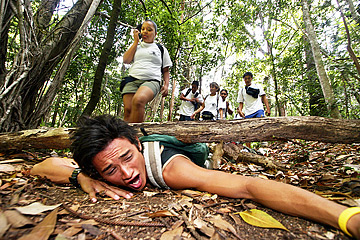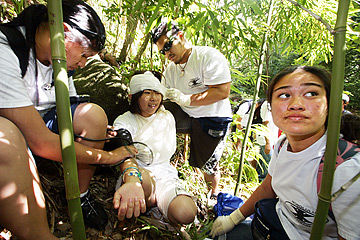
DENNIS ODA / DODA@STARBULLETIN.COM
Emergency Medical Technician Christopher "Tippy" Lee plays a victim who was knocked down by a falling tree limb, paralyzing him from the waist down, as students in the Junior Paramedic Program call for help. About 25 junior paramedics applied what they had learned in class as they hiked the Judd Trail last month during a four-week program offered by the city Emergency Medical Services Division. The program, which was offered for a second year, teaches lifesaving skills and gives teens a sense of what it's like to be an EMT as they visit the police, fire and lifeguard agencies and UH medical school.
|
|
Lifesavers reap rewards
The Junior Paramedic program not only teaches skills but offers teens a possible career
Tyler Higa lay on a metal backboard on the ground simulating an injured person who had suffered a fall.
Caleb Barrett wrapped a thick Velcro band around Higa's arm to check his blood pressure.
With a cervical collar placed around his neck and the rest of his body strapped securely to the backboard, Higa told his teammates that it was time to lift him.
"It's tight," said Barrett, 16, of the Word of Life Academy, who pulled on the multiple straps before he and two others lifted Higa off the ground in a classroom at the Honolulu Fire Department's Training Center near Honolulu Airport.
Ian Santee, director for the Junior Paramedic Program, stood nearby to observe the students' C-spine procedure and said, "OK, switch."
Twenty-five students are participating in a four-week Junior Paramedic Program offered by the city Emergency Medical Services Division. This is the second year EMS is offering the program to youth ages 14 to 18.
Santee said the program was established for two reasons: to teach lifesaving skills such as first aid and cardiopulmonary resuscitation, and as a recruitment tool.
There is a constant need for paramedics, said Chief Patty Dukes of the Emergency Medical Services Division. And teens are making critical decisions about what type of career they plan to enter.

DENNIS ODA / DODA@STARBULLETIN.COM
Sandra Ng, 17, plays a victim who fell along the trail as she is treated by fellow junior paramedics, from left, Charlote Fernandez, Andrew Savaiinaea and Kealohilani Holt.
|
|
About 20 percent of an estimated 160 paramedics with the Emergency Medical Services are at an age where they can make plans for retirement, Dukes said.
That means that five years from now, EMS could be recruiting paramedics, she said.
Ideally, EMS officials want to have at least 184 to 190 paramedics on staff. "It's a pretty demanding position, physically and emotionally," Dukes said.
Seventeen-year-old Sandra Ng, who graduated from Kalani High School this year, said her older sister dragged her to participate in the program with her last year.
"I never really knew what I liked to do," Ng said. After participating in the program, she was drawn to the hands-on, active lifestyle of paramedics. She returned for a second trial.
"It seems exciting ... it's something new everyday," she said. "The more I learn, the more excited I get."
Ng said she plans to attend the University of Hawaii in the fall to major in nursing, and later study to become a paramedic.
"I like helping people," she said.
During the program, students visit the Honolulu Police and Fire departments, Ocean Safety and Lifeguard Services Division and the UH John A. Burns School of Medicine to learn how Emergency Medical Services work closely with various agencies.
Every Friday, Santee and three other instructors take the students to various places on Oahu to apply what they learned in the classrooms in "life-like scenarios," he said.
Recently program instructors took them to Judd Trail in Nuuanu, where they practiced procedures on each other. They learned to use an automated external defibrillator, how to bandage a broken finger and how to apply a splint properly.
Along with lifesaving skills, Santee said students also learn about teamwork. "We give them lifelong skills," he said.

